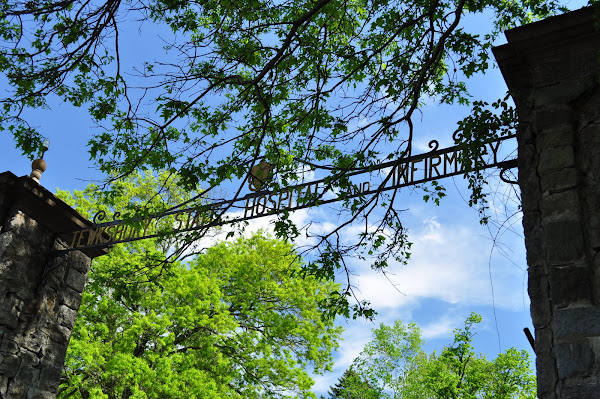Old Administration Building, built 1894
Tewksbury Hospital was one of the state run almshouses established in 1852. The Bridgewater, Monson and Tewksbury Almshouse were opened to accommodate an increasing number of destitute immigrants in Massachusetts.
The Bridgewater Almshouse later become a correctional facility for "criminally insane", and Monson became "Massachusetts Hospital for Epileptics" in 1895. Tewksbury began accepting "pauper insane" in 1866. Alcoholics were treated in the course of expansion. The almshouse/ asylum also admitted patients with such contagious disease as TB, small pox and typhoid, but also remained as an almshouse, especially during the time of the Great Depression.
Wrought Iron Gare, circa 1900
Anne Sullivan was one of the "paupers". Abandoned by an alcoholic father from Ireland, Anne and her brother, Jimmy were admitted to the Tewksbury Almshouse in 1876. Like their mother, Jimmy is said to die from consumption only 3 months after the siblings' arrival to the almshouse.
Currently, Tewksbury Hospital is a state run facility for psychiatric and medical treatment. I visited the hospital for the Public Health Museum*, thinking about obtaining some historic materials and information about the hospital cemetery.
*Open Wednesdays 10am to 2pm, or by appointment. Please refer to my post: Stuck in the Emerson Iron Lung .
After visiting the museum, I decided to walk around the campus because a kid on a horse back caught my attention. I first thought how strange to see a horse on a hospital property, but it seems to be a part of Animal Assisted Therapy; that makes sense.
When established, the hospital was planned according to the cottage plan, a style gained popularity in the late 19th century asylums. Multiple building blocks, chiefly made with redbrick, dotted the broad campus. The patients were assigned to a specific ward or block sorted by the condition, gender, etc. Prior to this, all the types of patients were placed into a single, bat wing shaped building called the Kirkbride plan (i.e.: Danvers State Hospital in Danvers, Our Lady's Hospital in Cork.)
In the cottage plan, each building blocks were usually connected by underground tunnels; Tewksbury Hospital was no exception.
When you visit the museum, I recommend taking a closer look to an areal view of the campus drawn in the 30's. The museum guide who used to be the hospital worker told me the staff used to use tunnels for a dating spot. Since the nurse dormitory on the campus was under the watchful eyes of the superintendent, they met at "a secret spot" where they won't be seen or heard. I guess that's how a romance was carried out in the numerous state hospitals in Massachusetts... I'm thinking about proposing a plot based on hospital tunnels, possibly a noir type, to Scorsese, what do you think?
Currently, the tunnels are used for accommodating boilers, and hospital workers don't use them for going back and forth between buildings, forget about a secret dating spot! But you can still recognize some of the tunnel portals on the campus.
It was past 2pm, and I decided to sit down on a picnic table to eat some snack. I couldn't find any supermarket on the way to the hospital except a huge distribution center for a local supermarket chain.
Nibbling on a granola bar, I felt sort of déjà vu. There is a resemblance to Medfield State Hospital. Medfield was built in 1852, the year the Tewksbury Almshouse was established. The spread out, the cottage plan hospital grounds have a very similar feel of landscape. If Medfield State Hospital wasn't abandoned, it would have looked like Tewksbury, I thought.
In next post, I'll introduce more about Tewksbuty Hospital. Stay tuned.
Continue to: Stonecroft, Tewksbury
Locate Tewksbury Hospital @ Google Map
Tewksbury hospital, mass.gov
The Public Health Museum
Anne Sullivan, Perkins School for the Blind
State Hospitals of Massachusetts, 1856.org
Tewksbury State Hospital, Asylum Projects
Cottage Planned Institutions, Asylum Projects










Your guide was Duncan Hazel, who also gave me a tour of the museum last summer. What a privilege!
ReplyDeleteYup, it was him. I enjoyed the tour with him a lot, too!
Delete